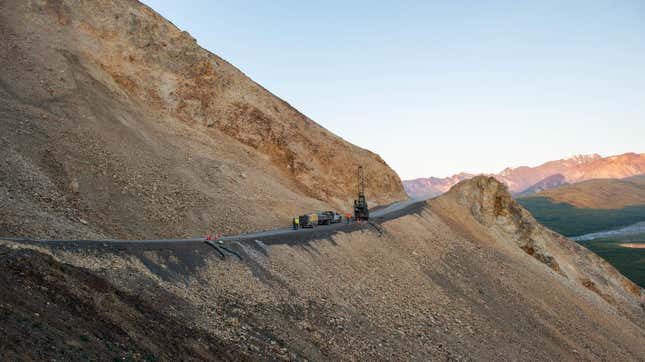
A landslide in Alaska’s iconic Denali National Park has closed the only road through the park and shut down activity weeks ahead of the normal end of tourist season. The cause: Rapidly thawing permafrost triggered a landslide that made the road too unstable to use.
The NPS said that the idyllically named Pretty Rocks Landslide, a known landslide the park’s road traverses en route to Polychrome Overlook, had become too dangerous for travel. Pretty Rocks sits about halfway along the 92-mile (148-kilometer) road that cuts across the 6-million-acre park. Thawing permafrost has been causing the road there to slowly drop for decades, but it has sped up to untenable rates this summer.
“Changing climate is driving frozen ground to thaw, resulting in unpredictable and increasing landslide movement rates at Pretty Rocks that are unprecedented in the history of the park road,” Don Striker, Denali’s Superintendent, said in a news release. “We cannot safely keep up with the accelerating rate of landslide movement caused by permafrost thaw currently occurring in association with the Pretty Rocks Landslide.”
The closure comes just a few weeks before the park’s annual Road Lottery, a four-day event in September when winners of a drawing are given the opportunity drive as far as they can go in one day on the road through the park. The first 15 miles (24 kilometers) of the road are usually the only ones open to individual private cars and trucks. The rest of the road is open to bus tours only outside the lottery, which offers a rare solitary peek at the deeper wilderness in the park.
“Landslide” often connotes swift and dangerous one-off events, but slow-moving landslides, like Pretty Rocks, are actually much more common. Pretty Rocks is also not just a bunch of rocks tumbling down a hill, but rather a whole chunk of the mountain that is slowly—until now anyways—moving downhill. In fact, it may be more accurately referred to as a “rock glacier.” Pretty Rocks lies under the roadbed at mile 41.5 (kilometer 67) of the Denali road along a particularly treacherous pass near Polychrome Overlook, where the thin road winds through steep slopes.
Park officials have been keeping an eye on this specific landslide—and the aggressive and worrisome ways climate change is making it move faster—for a few years now. The landslide has been active since the 1960s, but normally only required minimal maintenance every couple of years. But the quickly warming temperatures in Alaska have destabilized the permafrost underlying much of the park and accelerating the slide’s movement. Between 2016 and 2017, a 100-yard (90 meter) section of the road starting collapsing at a rate of 0.2 inches (0.5 centimeters) per day. But the pace had picked up to 0.5 inches (1.3 centimeters) a day in 2018 and reached 3 inches (8 centimeters) per day as of last August.
By this summer, the National Park Service said it was trucking in up to 100 dump trucks’ worth of gravel each week just to keep Pretty Rocks passable. But that wasn’t enough to keep up with what happened this month. Heavy rain at the start of August appears to have accelerated the landslide rate to a whopping 10 inches (25 centimeters) per day.
“On August 24, park managers recognized that this solution was no longer tenable or safe and enacted a road closure to the east of Pretty Rocks,” the NPS wrote this week in an update to its Pretty Rocks landslide page. “As the area becomes more unstable, traditional road maintenance methods have become inadequate. The park’s ability to adapt to future conditions will require transitioning to more expensive and novel construction methods to maintain road-based access.”
Those methods could be very expensive. In 2019, Alaska Public Media reported that safely moving the road could cost tens of millions of dollars, and would likely have to be approved by Congress. (There are other ideas on the table, including tunneling under the road or building structures to hold back the rock slide, but a full cost analysis of solutions hasn’t been made public.)
And just fixing Pretty Rocks won’t fix the underlying problem of how warming is quickly changing the park and, indeed, all of Alaska. The NPS said there are more than 140 mapped unstable landslides along the park’s road. They still don’t know how much, exactly, climate change is destabilizing these landslides compared to tourist activity, but it’s likely we’ll see more and more of these landslides start to pick up speed as things heat up.
“If we want to understand how to maintain infrastructure in areas where we have permafrost like this, we need to understand how that’s going to respond to continued warming,” Denny Capps, a Denali park geologist, told Alaska Public Media.
Extreme heat in other parts of the Arctic has had similar deleterious effects, unleashing landslides in Canada and even causing the tundra to explode in Siberia. It could have serious consequences for those who call the Arctic home, with a third of all Arctic infrastructure at risk from the thaw.